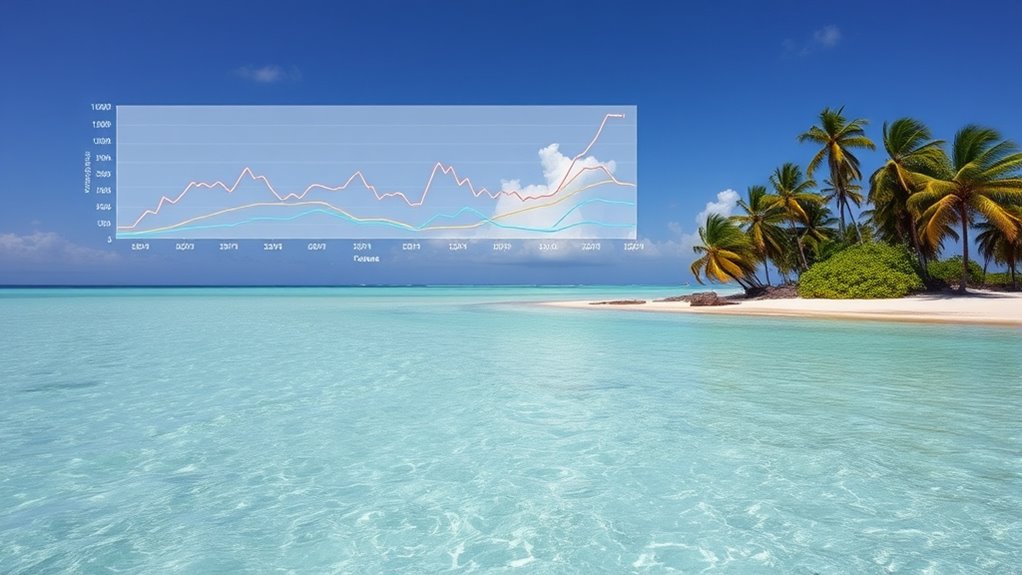Climate models predict sea-level rise for the Marshall Islands by simulating how increased greenhouse gases warm the oceans, causing ice sheets and glaciers to melt. These models also factor in ocean acidification and coral bleaching, which weaken reefs that protect coastlines. As these natural buffers deteriorate, the islands become more vulnerable to flooding and erosion. To understand how these complex interactions influence future sea levels, you’ll discover more below.
Key Takeaways
- Climate models simulate ocean warming, ice melt, and their impacts on sea-level rise specific to the Marshall Islands.
- They incorporate biological data, like coral reef health, to assess coastal protection and vulnerability.
- Models account for chemical changes such as ocean acidification affecting reef resilience over time.
- They project future sea levels by combining physical, biological, and chemical factors influencing regional sea-level rise.
- Results inform community adaptation strategies and policies to mitigate flooding, erosion, and infrastructure risks.

Climate models are essential tools for understanding and predicting sea-level rise caused by climate change. When it comes to the Marshall Islands, these models help you grasp how rising temperatures and changing ocean conditions threaten your homeland. One of the key factors affecting sea levels is the health of coral reefs, which are crucial to the region’s ecosystem and economy. As global temperatures increase, coral bleaching becomes more frequent and severe, weakening reef structures that normally help buffer coastlines from erosion and storm surges. When corals bleach, they lose their vibrant colors and indispensable symbiotic algae, leaving them vulnerable to death. This deterioration reduces the physical barrier that reefs provide, making coastal areas more susceptible to the impacts of rising seas. Ocean acidification, another consequence of increased carbon dioxide in the atmosphere, plays a significant role in this process. As CO2 dissolves into seawater, it lowers the water’s pH, impairing corals’ ability to calcify and build their skeletons. This weakens the entire reef system, accelerating coral bleaching and further diminishing their capacity to protect islands like yours from sea-level rise. Climate models consider these biological and chemical interactions to project future scenarios. They use complex algorithms to simulate how increased greenhouse gases lead to warmer ocean temperatures, which directly trigger coral stress and bleaching events. Simultaneously, the models incorporate data on ocean acidification, illustrating how ongoing CO2 absorption will continue to hinder reef growth and resilience. By integrating these factors, the models predict that coral reefs around the Marshall Islands will likely become less capable of mitigating the impacts of sea-level rise over time. This means your islands could face more frequent flooding, erosion, and damage to infrastructure if current trends persist. The models also factor in how melting ice sheets and glaciers contribute to global sea-level rise, which compounds the problem. As you observe these predictions, it’s clear that addressing coral bleaching and ocean acidification isn’t just about preserving marine life; it’s about safeguarding your community’s future. The models underscore the urgency of reducing greenhouse gas emissions and implementing adaptation strategies. They help you understand that protecting coral reefs from bleaching and acidification can buy you time and reduce the severity of sea-level rise impacts. Additionally, advancements in encryption solutions and cybersecurity can play a vital role in protecting critical infrastructure and data related to climate resilience efforts. Overall, climate models offer a crucial glimpse into the complex web of interactions affecting your islands. They provide the scientific foundation for policies and actions to defend against rising seas, emphasizing that tackling ocean health is integral to your resilience and survival.
Frequently Asked Questions
How Accurate Are Current Climate Models for Small Island Nations?
You might wonder how accurate current climate models are, especially for small island nations. These models consider factors like ocean currents and volcanic activity, which influence sea levels. While they provide valuable insights, uncertainties remain due to complex interactions and limited data. You should recognize that predictions are improving with better technology, but small islands still face challenges in precisely forecasting sea-level rise, emphasizing the need for localized research and adaptive strategies.
What Local Factors Influence Sea-Level Rise Predictions in the Marshall Islands?
You should consider how local factors like coral bleaching weaken reef structures, reducing natural barriers against sea-level rise. Coastal erosion from storms and wave action also plays a significant role, making predictions more complex. These factors can accelerate flooding and land loss, so climate models must account for them to provide accurate sea-level rise forecasts for the Marshall Islands. Your understanding of these local issues is vital for effective planning and adaptation.
How Do Climate Models Account for Unexpected Climate Variability?
Imagine climate models as sailors steering unpredictable seas; unexpected climate variability is like sudden storms. You’re aware these storms can change course unexpectedly, so you make model adjustments—adding new data, refining algorithms—to stay on course. This process helps models adapt to unforeseen changes, improving their accuracy. By continuously adjusting, you guarantee your predictions remain reliable, even when the climate’s behavior surprises you.
Can Models Predict Specific Impacts on Marshall Islands Communities?
You can’t predict exact impacts on Marshall Islands communities, but climate models help identify potential risks like flooding and erosion. By understanding these risks, you can bolster community resilience and develop effective adaptation strategies. Models guide decisions on coastal defenses and relocation plans, empowering you to better prepare for sea-level rise. This proactive approach helps protect your community and ensures long-term sustainability despite climate uncertainties.
What Are the Limitations of Climate Models in Forecasting Long-Term Sea-Level Changes?
Think of climate models as weather vanes in a swirling storm—useful but not perfect. You need to know their limitations, like model uncertainties that can blur long-term forecasts. Data resolution matters too; coarse data can miss tiny yet vital shifts. These factors make predicting precise sea-level rises tricky over decades, so you should see models as guides rather than crystal balls, always subject to refinement and change.
Conclusion
So, as you consider the future of the Marshall Islands, imagine the rising waters lapping closer each year. Climate models show that if we don’t act now, these beautiful islands could be swallowed by the sea. Can you see the waves reaching for the shores, erasing memories and homes? It’s a stark reminder that your choices today shape tomorrow’s coastlines. Will you help turn the tide before it’s too late?










